Collaboration and Competition: A Social Network Analysis of Thailand’s Music Industry
Abstract
:1. Introduction
2. Literature Review
2.1. Concentration among Music Stakeholders
2.2. Power Law Distributions and Long Tails in the Music Production Network
2.3. Network Analysis
3. Data and Methodologies
3.1. Data Preparation
3.2. Data Description
3.3. Analytical Framework
3.4. Easley–Kleinberg Model
3.5. Network and Centrality Analysis
- Average degree: The average degree of a network is the average number of edges per node in the network (Klärner et al. 2022). It is calculated by dividing the total number of connections by the total number of nodes (Scott 1991; Iacobucci et al. 2017);
- Average weighted degree: The average weighted degree is a graph computed with weighted edges (Radhakrishnan et al. 2014). It is the average mean of the sum of the weights of incident edges on nodes in the graph;
- Average path length: The average path length is the average distance between all pairs in a particular network (Hevey 2018; Pachayappan and Venkatesakumar 2018);
- Network diameter: The network diameter is the longest path between a pair of nodes in the network, and this indicator represents the width of the network (Parhami and Yeh 2000; Bögenhold 2013; Klärner et al. 2022);
- Connected components: The connected component of an undirected graph is a maximal set of nodes wherein a path connects each pair of nodes (Hirschberg et al. 1979). Connected components in a graph refer to nodes connected by paths;
- Modularity: Modularity is a measure of the structure of networks or graphs which measures the strength of the division of a network into communities. Networks with high modularity have dense connections between the nodes within modules but sparse connections between nodes in different modules (Sosa et al. 2007). Modularity is the fraction of edges that fall within groups 1 or 2 minus the expected number of edges within groups 1 and 2 for a random graph with the same node degree distribution as the given network (Blondel et al. 2008; Pachayappan and Venkatesakumar 2018).
- Degree centrality: Degree centrality is one of the most intuitive indicators of a node’s effect on the overall network (Scott 1991; Freeman 2002). It is the sum of a node’s degrees based on the number of connections a node has to other nodes. Its value can also be used to standardize this measure by specifying the maximum number of possible links (Zhang and Hu 2021);
- Betweenness centrality: Betweenness centrality is based on the number of shortest paths between pairs of nodes that pass a given node (Freeman 2002). It is from one of the important properties of a particular node, which is the function of transmitting physical matter. So, nodes with a high betweenness centrality are located on many shortest paths and can play a key role in connecting other nodes in the network (Pachayappan and Venkatesakumar 2018; Klärner et al. 2022);
- Eigencentrality: Eigencentrality is based on the concept of eigenvectors in linear algebra. It has been developed by summing only linkages connected to important nodes (Bonacich 1987). Thus, this measure is the principal eigenvector of the graph’s adjacency matrix, representing the strength of the node connections. Therefore, a node with high eigencentrality is connected to other nodes with high eigen centrality, giving it a high level of influence within the network (Budner and Grahl 2016; Pachayappan and Venkatesakumar 2018; Klärner et al. 2022);
- PageRank centrality: PageRank centrality measures the centrality of a node in a network, which Google developed as part of its search algorithm (Brin and Page 1998). It is calculated by iteratively updating each node’s importance based on the nodes it is connected to (Zhang and Hu 2021).
3.6. Watts–Strogatz Model
4. Results and Discussions
4.1. Empirical Tests for Easley–Kleinberg Model
4.2. Network Analysis Results
4.3. Analyses of Centrality Indices
4.4. Empirical Test for Watts–Strogatz Model
4.5. Summary of Discussions and Recommendations
4.6. Limitations and Future Research
5. Conclusions
Author Contributions
Funding
Informed Consent Statement
Data Availability Statement
Conflicts of Interest
References
- Abbasi, Alireza, Jörn Altmann, and Liaquat Hossain. 2011. Identifying the effects of co-authorship networks on the performance of scholars: A correlation and regression analysis of performance measures and social network analysis measures. Journal of Informetrics 5: 594–607. [Google Scholar] [CrossRef]
- Aguiar, Luis, and Joel Waldfogel. 2015. Streaming Reaches Flood Stage: Does Spotify Stimulate or Depress Music Sales? NBER Working Paper Series, no. 21653 (October 2015); Cambridge: National Bureau of Economic Research. Available online: http://www.nber.org/papers/w21653 (accessed on 18 May 2023).
- Aguiar, Luis, and Joel Waldfogel. 2017. Quality Predictability and the Welfare Benefits from New Products: Evidence from the Digitization of Recorded Music. Journal of Political Economy 126: 1–33. [Google Scholar] [CrossRef]
- Aguiar, Luis, and Joel Waldfogel. 2021. Platforms, power, and promotion: Evidence from Spotify playlists. The Journal of Industrial Economics 69: 653–91. [Google Scholar] [CrossRef]
- Aguiar, Luis, Imke Reimers, and Joel Waldfogel. 2023. Platforms and the transformation of the content industries. Journal of Economics & Management Strategy. Early View. [Google Scholar] [CrossRef]
- Ahmed, Adel, Vladimir Batagelj, Xiaoyan Fu, Seok-hee Hong, Damian Merrick, and Andrej Mrvar. 2007. Visualisation and Analysis of the Internet Movie Database. Paper presented at 2007 6th International Asia-Pacific Symposium on Visualization, Sydney, NSW, Australia, February 5–7; Piscataway: IEEE, pp. 17–24. [Google Scholar] [CrossRef]
- Alarcao, André, and Mário Neto. 2016. Actor centrality in Network Projects and scientific performance: An exploratory study. RAI Revista de Administração e Inovação 13: 78–88. [Google Scholar] [CrossRef]
- Albert, Réka, Hawoong Jeong, and Albert-László Barabási. 1999. Diameter of the world-wide web. Nature 401: 130–31. [Google Scholar] [CrossRef]
- Amorndoljai, Punyanut, Surasak Taneepanichskul, Sunyarn Niempoog, and Ubonthip Nimmannit. 2015. Improving of knee osteoarthritic symptom by the local application of ginger extract nanoparticles: A preliminary report with short term follow-up. Journal of the Medecal Assocociation of Thailand 98: 871–77. Available online: http://www.jmatonline.com/index.php/jmat/article/view/6505 (accessed on 12 October 2023).
- Anderson, Chris. 2006. The Long-Tail: Why the Future of Business Is Selling Less of More. New York: Hachette Books. Available online: https://www.hachettebookgroup.com/titles/chris-anderson/the-long-tail/9781401384630/?lens=achette-books (accessed on 18 May 2023).
- Autor, David, David Dorn, Lawrence F. Katz, Christina Patterson, and John Van Reenen. 2020. The Fall of the Labor Share and the Rise of Superstar Firms. The Quarterly Journal of Economics 135: 645–709. [Google Scholar] [CrossRef]
- Bagley, Mark J. O., Ethan Gifford, and Maureen McKelvey. 2022. The evolution of niche: Variety in knowledge networks in the global music industry. Industry and Innovation 29: 425–62. [Google Scholar] [CrossRef]
- Barabási, Albert-László. 2003. Linked: The New Science of Networks. Cambridge, MA: Perseus Publishing. [Google Scholar]
- Barabási, Albert-László. 2009. Scale-free networks: A decade and beyond. Science 325: 412–13. [Google Scholar] [CrossRef]
- Barnes, John A. 1954. Class and committees in a Norwegian island parish. Human Relations 7: 39–58. [Google Scholar] [CrossRef]
- Barthélemy, Marc. 2011. Spatial networks. Physics Reports 499: 1–101. [Google Scholar] [CrossRef]
- Baym, Nancy, Rachel Bergmann, Raj Bhargava, Fernando Diaz, Tarleton Gillespie, David Hesmondhalgh, Elena Maris, and Christopher J. Persaud. 2021. Making sense of metrics in the music industries. International Journal of Communication 15: 3418–41. Available online: https://ijoc.org/index.php/ijoc/article/view/17635 (accessed on 12 October 2023).
- Benner, Mary J., and Joel Waldfogel. 2023. Changing the channel: Digitization and the rise of “middle tail” strategies. Strategic Management Journal 44: 264–87. [Google Scholar] [CrossRef]
- Blondel, Vincent D., Jean-Loup Guillaume, Renaud Lambiotte, and Etienne Lefebvre. 2008. Fast unfolding of communities in large networks. Journal of Statistical Mechanics: Theory and Experiment 2008: P10008. [Google Scholar] [CrossRef]
- Bögenhold, Dieter. 2013. Social network analysis and the sociology of economics: Filling a blind spot with the idea of social embeddedness. American Journal of Economics and Sociology 72: 293–318. [Google Scholar] [CrossRef]
- Bolland, John M. 1988. Sorting out centrality: An analysis of the performance of four centrality models in real and simulated networks. Social Networks 10: 233–53. [Google Scholar] [CrossRef]
- Bollobás, Béla, and Oliver Riordan. 2005. The critical probability for random Voronoi percolation in the plane is 1/2. Probability Theory and Related Fields 136: 417–68. [Google Scholar] [CrossRef]
- Bonacich, Phillip. 1987. Power and centrality: A family of measures. American Journal of Sociology 92: 1170–82. Available online: https://www.jstor.org/stable/2780000 (accessed on 18 May 2023). [CrossRef]
- Bonacich, Phillip. 2007. Some unique properties of eigenvector centrality. Social Networks 29: 555–64. [Google Scholar] [CrossRef]
- Boonthanapat, Naris, Kaewalee Soontornmon, Petchawan Pungrassami, Junthira Sukhasitwanichkul, Surakameth Mahasirimongkol, Chuleeporn Jiraphongsa, Patama Monkongdee, Kittipat Angchokchatchawal, and Anuwat Wiratsudakul. 2019. Use of network analysis multidrug resistant tuberculosis contact investigation in Kanchanaburi, Thailand. Tropical Medicine & International Health 24: 320–27. [Google Scholar] [CrossRef]
- Borgatti, Stephen P. 2005. Centrality and network flow. Social Networks 27: 55–71. [Google Scholar] [CrossRef]
- Brin, Sergey, and Lawrence Page. 1998. The anatomy of a large-scale hypertextual Web search engine. Computer Networks and ISDN Systems 30: 107–17. [Google Scholar] [CrossRef]
- Bryan, Nicholas J., and Gen Wang. 2011. Musical Influence Network Analysis and Rank of Sample-Based Music. Paper presented at 12th International Society for Music Information Retrieval Conference, Miami, FL, USA, October 24–28; Stanford: Stanford University, pp. 329–34. Available online: https://ccrma.stanford.edu/~njb/research/influence.pdf (accessed on 18 May 2023).
- Brynjolfsson, Erik, Yu Hu, and Michael D. Smith. 2010. Research commentary—Long-tails vs. superstars: The effect of information technology on product variety and sales concentration patterns. Information Systems Research 21: 736–47. [Google Scholar] [CrossRef]
- Brynjolfsson, Erik, Yu Jeffrey Hu, and Michael D. Smith. 2006. From niches to riches: Anatomy of the long-tail. Sloan Management Review 47: 67–71. Available online: https://ssrn.com/abstract=918142 (accessed on 18 May 2023).
- Budner, Pascal, and Joern Grahl. 2016. Collaboration Networks in the Music Industry. Köln: University of Cologne. [Google Scholar] [CrossRef]
- Byun, Chong Hyun Christie. 2016. The Economics of the Popular Music Industry: Modelling from Microeconomic Theory and Industrial Organization. New York: Palgrave Pivot. [Google Scholar] [CrossRef]
- Celma, Oscar. 2010. Music recommendation. In Music Recommendation and Discovery: The Long-Tail, Long Fail, and Long Play in the Digital Music Space. Berlin and Heidelberg: Springer, pp. 43–85. [Google Scholar] [CrossRef]
- Chen, Wenhong. 2015. Mediatizing the network model of cultural capital: Network diversity, media use, and cultural knowledge along and across ethnic boundaries. Social Networks 40: 185–96. [Google Scholar] [CrossRef]
- De Deyne, Simon, Danielle J. Navarro, Amy Perfors, Marc Brysbaert, and Gert Storms. 2019. The “Small World of Words” English word association norms for over 12,000 cue words. Behavior Research Methods 51: 987–1006. [Google Scholar] [CrossRef] [PubMed]
- Department of Intellectual Property Thailand. 2021. List of All Songs (Kor—Hor); Nonthaburi: Department of Intellectual Property, Ministry of Commerce. Available online: https://www.ipthailand.go.th/th/copyright-010/item/kor-hor.html (accessed on 5 January 2021).
- Di Tommaso, Giorgia, Mauro Gatti, Michela Iannotta, Ajay Mehra, Giovanni Stilo, and Paola Velardi. 2020. Gender, rank, and social networks on an enterprise social media platform. Social Networks 62: 58–67. [Google Scholar] [CrossRef]
- Donker, Silvia. 2019. Networking Data. A Network Analysis of Spotify’s Socio-Technical Related Artist Network. International Journal of Music Business Research 8: 67–101. Available online: https://core.ac.uk/download/pdf/232529815.pdf (accessed on 12 July 2023).
- Drott, Eric. 2021. Copyright, compensation, and commons in the music AI industry. Creative Industries Journal 14: 190–207. [Google Scholar] [CrossRef]
- Easley, David, and Jon Kleinberg. 2010. Networks, Crowds, and Markets: Reasoning about a Highly Connected World. Cambridge: Cambridge University Press. Available online: https://ds.amu.edu.et/xmlui/bitstream/handle/123456789/14747/Networks-book%20-%20833%20pages.pdf?sequence=1&isAllowed=y (accessed on 18 May 2023).
- Erdős, Paul, and Alfréd Rényi. 1959. Some further statistical properties of the digits in Cantor’s series. Acta Mathematica Academiae Scientiarum Hungarica 10: 21–29. [Google Scholar] [CrossRef]
- Euler, Leonhard. 1736. Mechanica Sive Motus Scientia Analytice Exposita: Instar Supplementi Ad Commentar. Acad. Scient. Imper. Ex typographia academiae scientiarum. vol. 2, Available online: https://books.google.com/books?hl=th&lr=&id=Id_FWenUwYIC&oi=fnd&pg=PA1&dq=Euler,+Leonhard.+1736.+Mechanica+Sive+Motus+Scientia+Analytice+Exposita:+Instar+Supplementi+Ad+Commentar.+Acad.+Scient&ots=4fBU_XpJQr&sig=hrWBgNBslRKdqWN_JPcVaax3ueo (accessed on 12 July 2023).
- Everett, Martin G., and Stephen P. Borgatti. 1999. The centrality of groups and classes. The Journal of Mathematical Sociology 23: 181–201. [Google Scholar] [CrossRef]
- Felton, Emma, Christy Collis, and Philip Graham. 2010. Making Connections: Creative Industries Networks in Outer-Suburban Locations. Australian Geographer 41: 57–70. [Google Scholar] [CrossRef]
- Fields, Ben, Kurt Jacobson, Christophe Rhodes, Mark d’Inverno, Mark Sandler, and Michael Casey. 2011. Analysis and Exploitation of Musician Social Networks for Recommendation and Discovery. IEEE Transactions on Multimedia 13: 674–86. [Google Scholar] [CrossRef]
- Frank, Ove. 1978. Sampling and estimation in large social networks. Social Networks 1: 91–101. [Google Scholar] [CrossRef]
- Freeman, Linton C. 2002. Centrality in social networks: Conceptual clarification. In Social Network: Critical Concepts in Sociology. Edited by John Scott. London: Routledge, vol. 1, pp. 238–63. Available online: https://www.bebr.ufl.edu/sites/default/files/Centrality%20in%20Social%20Networks.pdf (accessed on 12 October 2023).
- Freeman, Linton. 2004. The Development of Social Network Analysis: A Study in the Sociology of Science. Vancouver: Empirical Press, pp. 28–33. [Google Scholar]
- Freeman, Linton C., Douglas Roeder, and Robert R. Mulholland. 1979. Centrality in social networks: II. Experimental results. Social Networks 2: 119–41. [Google Scholar] [CrossRef]
- Gayer, Amit, and Oz Shy. 2003. Internet and Peer-to-Peer Distributions in Markets for Digital Products. Economics Letters 81: 197–203. [Google Scholar] [CrossRef]
- Gladwell, Malcolm. 2002. The Talent Myth: Are Smart People Overatred? The New Yorker. Available online: https://www.newyorker.com/magazine/2002/07/22/the-talent-myth (accessed on 5 December 2023).
- Gneiser, Martin, Julia Heidemann, Mathias Klier, Andrea Landherr, and Florian Probst. 2012. Valuation of online social networks taking into account users’ interconnectedness. Information Systems and e-Business Management 10: 61–84. [Google Scholar] [CrossRef]
- Godart, Frédéric, and Ashley Mears. 2022. Transitory ties: A network ecology perspective on job opportunities in fashion modeling. Social Networks. In Press. [Google Scholar] [CrossRef]
- Goodrich, Peter, Stan Renard, and Nancy Rossiter. 2011. Social Network Analysis of the Music Industry: From Barrel Organ to Youtube. Nashville: Academic and Business Research Institute International. Available online: https://www.researchgate.net/profile/Stan-Renard/publication/340493005_Social_network_analysis_of_the_music_industry_from_barrel_organ_To_Youtube/links/5e8d0011299bf1307985d4cb/Social-network-analysis-of-the-music-industry-from-barrel-organ-To-Youtube.pdf (accessed on 18 May 2023).
- Gowers, Andrew. 2006. Gowers Review of Intellectual Property; London: The Stationery Office. Available online: https://assets.publishing.service.gov.uk/media/5a7c9f7740f0b65b3de0a17d/0118404830.pdf (accessed on 12 October 2023).
- Grando, Felipe, Lisandro Z. Granville, and Luis C. Lamb. 2018. Machine learning in network centrality measures: Tutorial and outlook. ACM Computing Surveys (CSUR) 51: 1–32. [Google Scholar] [CrossRef]
- Granovetter, Mark S. 1973. The strength of weak ties. American Journal of Sociology 78: 1360–80. [Google Scholar] [CrossRef]
- Gunaratna, Charith, Evan Stoner, and Ronaldo Menezes. 2011. Using Network Sciences to Rank Musicians and Composers in Brazilian Popular Music. Paper presented at 12th International Society for Music Information Retrieval Conference (ISMIR 2011), Miami, FL, USA, October 24–28; Available online: https://archives.ismir.net/ismir2011/paper/000080.pdf (accessed on 12 July 2023).
- Hesmondhalgh, David, Richard Osborne, Hyojung Sun, and Kenny Barr. 2021. Music Creators’ Earnings in the Digital Era. New Port: Intellectual Property Office Research Paper Forthcoming. Available online: https://ssrn.com/abstract=4089749 (accessed on 27 January 2024).
- Hevey, David. 2018. Network analysis: A brief overview and tutorial. Health Psychology and Behavioral Medicine 6: 301–28. [Google Scholar] [CrossRef]
- Hirschberg, Daniel S., Ashok K. Chandra, and Dilip V. Sarwate. 1979. Computing connected components on parallel computers. Communications of the ACM 22: 461–64. [Google Scholar] [CrossRef]
- Humphries, Mark D., and Kevin Gurney. 2008. Network ‘Small-World-Ness’: A Quantitative Method for Determining Canonical Network Equivalence. PLoS ONE 3: e0002051. [Google Scholar] [CrossRef]
- Iacobucci, Dawn, Rebecca McBride, Deidre Popovich, and Maria Rouziou. 2017. In social network analysis, which centrality index should I use? Theoretical differences and empirical similarities among top centralities. Journal of Methods and Measurement in the Social Sciences 8: 72–99. [Google Scholar] [CrossRef]
- IFPI. 2020. Global Music Report 2020; London: International Federation of the Phonographic Industry. Available online: https://www.ifpi.org/news/Global-Music-Report-2020 (accessed on 18 May 2023).
- Im Kampe, Eveline Otte, Ann-Sophie Lehfeld, Silke Buda, Udo Buchholz, and Walter Haas. 2020. Surveillance of COVID-19 school outbreaks, Germany, March to August 2020. Eurosurveillance 25: 2001645. [Google Scholar] [CrossRef]
- Jain, Sanjay. 2020. Fumbling to the future? Socio-technical regime change in the recorded music industry. Technological Forecasting and Social Change 158: 120168. [Google Scholar] [CrossRef]
- Ji, Shulei, Jing Luo, and Xinyu Yang. 2020. A comprehensive survey on deep music generation: Multi-level representations, algorithms, evaluations, and future directions. arXiv arXiv:2011.06801. [Google Scholar] [CrossRef]
- Joel, Sian. 2009. A Social Network Analysis Approach to a Social Model of the Creative Industries: The Design Sub-Sector. Creative Industries Journal 2: 191–201. [Google Scholar] [CrossRef]
- Jones, Pete, Eithne Quinn, and Johan Koskinen. 2020. Measuring Centrality in Film Narratives Using Dynamic Character Interaction Networks. Social Networks 63: 21–37. [Google Scholar] [CrossRef]
- Kagan, Dima, Thomas Chesney, and Michael Fire. 2020. Using data science to understand the film industry’s gender gap. Palgrave Communications 6: 92. [Google Scholar] [CrossRef]
- Kanellopoulou, Jenny. 2021. Competition Policy and the Music Industries: A Business Model Perspective. London: Routledge. [Google Scholar] [CrossRef]
- Karpov, Ilia, and Roman Marakulin. 2021. Social Network Analysis of the Professional Community Interaction—Movie Industry Case. Paper presented at 23rd International Conference on Data Analytics and Management in Data Intensive Domains, Moscow, Russia, October 26–29; Cham: Springer International Publishing, pp. 36–50. [Google Scholar]
- Kietzmann, Jan H., Kristopher Hermkens, Ian P. McCarthy, and Bruno S. Silvestre. 2011. Social media? Get serious! Understanding the functional building blocks of social Media. Business Horizons 54: 241–51. [Google Scholar] [CrossRef]
- Kim, Yonghwan, and Hsuan-Ting Chen. 2015. Discussion network heterogeneity matters: Examining a moderated mediation model of social media use and civic engagement. International Journal of Communication 9: 2344–65. [Google Scholar]
- Klärner, Andreas, Markus Gamper, Sylvia Keim-Klärner, Irene Moor, Holger von der Lippe, and Nico Vonneilich. 2022. Social Networks and Health Inequalities: A New Perspective for Research. Cham: Springer Nature, p. 343. [Google Scholar] [CrossRef]
- Ko, Tobey H., and Henry Y. K. Lau. 2015. A Brand Premium Pricing Model for Digital Music Market. International Journal of Trade, Economics, and Finance 6: 117–24. [Google Scholar] [CrossRef]
- Krueger, Alan B. 2019. Rockonomics: A Backstage Tour of What the Music Industry Can Teach Us about Economics and Life. Currency. Available online: https://scholar.google.com/citations?view_op=view_citation&hl=th&user=5fY6_jMAAAAJ&cstart=100&pagesize=100&citation_for_view=5fY6_jMAAAAJ:bxPAEoiBajcC (accessed on 18 May 2023).
- Landherr, Andrea, Bettina Friedl, and Julia Heidemann. 2010. A critical review of centrality measures in social networks. Wirtschaftsinformatik 52: 367–82. [Google Scholar] [CrossRef]
- Lee, Minha. 2015. Fostering Connectivity: A Social Network Analysis of Entrepreneurs in Creative industries. International Journal of Cultural Policy 21: 139–52. [Google Scholar] [CrossRef]
- Leyshon, Andrew. 2001. Time–Space (and Digital) Compression: Software Formats, Musical Networks, and the Reorganisation of the Music Industry. Environment and Planning 33: 49–77. [Google Scholar] [CrossRef]
- Lin, Cheng-Yi. 2014. The Evolution of Taipei’s Music Industry: Cluster and Network Dynamics in the Innovation Practices of the Music Industry. Urban Studies 51: 335–54. [Google Scholar] [CrossRef]
- Malinick, Todd E., David B. Tindall, and Mario Diani. 2013. Network centrality and social movement media coverage: A two-mode network analytic approach. Social Networks 35: 148–58. [Google Scholar] [CrossRef]
- McAndrew, Siobhan, and Martin Everett. 2015. Music as Collective Invention: A Social Network Analysis of Composers. Cultural Sociology 9: 56–80. [Google Scholar] [CrossRef]
- Milgram, Stanley. 1967. The small world problem. Psychology Today 2: 60–67. Available online: http://snap.stanford.edu/class/cs224w-readings/milgram67smallworld.pdf (accessed on 15 July 2023).
- Moon, Shin-Il, George A. Barnett, and Yon Soo Lim. 2010. The Structure of International Music Flows Using Network Analysis. New Media & Society 12: 379–99. [Google Scholar] [CrossRef]
- Newman, Mark E. J. 2005. Power laws, Pareto distributions and Zipf’s law. Contemporary Physics 46: 323–51. [Google Scholar] [CrossRef]
- Noopataya, Supot, Sukanya Thongratsakul, and Chaithep Poolkhet. 2015. Social network analysis of cattle movement in Sukhothai province, Thailand: A study to improve control measurements. Veterinary Medicine International 2015: 587252. [Google Scholar] [CrossRef] [PubMed]
- Noroozian, Ali, Babak Amiri, and Mehrdad Agha Mohammad Ali Kermani. 2022. Investigation of cinematic genre diversity based on social network analysis: The lost ring of the Iranian cinema industry. Kybernetes. ahead-of-print. [Google Scholar] [CrossRef]
- Oberholzer-Gee, Felix, and Koleman Strumpf. 2007. The effect of file sharing on record sales: An empirical analysis. Journal of Political Economy 115: 1–42. [Google Scholar] [CrossRef]
- Pachayappan, Murugaiyan, and Ramakrishnan Venkatesakumar. 2018. A graph theory based systematic literature network analysis. Theoretical Economics Letters 8: 960–80. [Google Scholar] [CrossRef]
- Parhami, Behrooz, and Chi-Hsiang Yeh. 2000. Why Network Diameter Is Still Important. Paper presented at International Conference Communications in Computing, Las Vegas, NV, USA, June 26–29; Available online: https://web.ece.ucsb.edu/~parhami/pubs_folder/parh00c-cic-why-network-diam-important.pdf (accessed on 12 October 2023).
- Phimpraphai, Waraphon, Sirikachorn Tangkawattana, Suwicha Kasemsuwan, and Banchob Sripa. 2018. Social influence in liver fluke transmission: Application of social network analysis of food sharing in Thai Isaan culture. Advances in Parasitology 101: 97–124. [Google Scholar] [CrossRef]
- Piccolo, Sebastiano A., Sune Lehmann, and Anja Maier. 2018. Design process robustness: A bipartite network analysis reveals the central importance of people. Design Science 4: e1. [Google Scholar] [CrossRef]
- Prey, Robert, Marc Esteve Del Valle, and Leslie Zwerwer. 2022. Platform pop: Disentangling Spotify’s intermediary role in the music industry. Information, Communication & Society 25: 74–92. [Google Scholar] [CrossRef]
- Prinz, Aloys. 2017. Rankings as Coordination Games: The Dutch Top 2000 Pop Song Ranking. Journal of Cultural Economics 41: 379–401. [Google Scholar] [CrossRef]
- Puttanapong, Nattapong. 2018. The Network Analysis of Interlocking Directors: The Case of Thailand’s Listed Companies. Paper presented at 24th Eurasia Business and Economics Society, Bangkok, Thailand, January 10–12; Bangkok: Eurasian Economic Perspectives, pp. 330–62. [Google Scholar]
- Radhakrishnan, Srinivasan, Rohit Jacob, Arjun Duvvuru, and Sagar Kamrthi. 2014. Organizing Patterns and Evolution of Indian Movie Industry. Procedia Computer Science 36: 655–59. [Google Scholar] [CrossRef]
- Rambarran, Shara. 2021. Virtual Music: Sound, Music, and Image in the Digital Era. London: Bloomsbury Publishing. Available online: https://books.google.com/books?hl=en&lr=&id=zZYXEAAAQBAJ&oi=fnd&pg=PR3&dq=Virtual+Reality+in+music+industry&ots=iAwF4s8ngg&sig=Jt-kFhH6SFDB_TFmFjbsBkgaGbU (accessed on 12 October 2023).
- Rayna, Thierry, and Ludmila Striukova. 2009. Monometapoly or the Economics of the Music Industry. Prometheus 27: 211–22. [Google Scholar] [CrossRef]
- Rehman, Abdul, Anand Paul, Awais Ahmad, and Gwanggil Jeon. 2020. A novel class-based searching algorithm in small world internet of drone network. Computer Communications 157: 329–35. [Google Scholar] [CrossRef]
- Sankowska, Anna, and Dariusz Siudak. 2016. The Small World Phenomenon and Assertive Mixing in Polish Corporate Board and Director Networks. Physica A 443: 309–15. [Google Scholar] [CrossRef]
- Scott, John. 1991. Methods of Network Analysis. The Sociological Review 39: 155–63. [Google Scholar] [CrossRef]
- Scott, John. 2012. What Is Social Network Analysis? London: Bloomsbury Academic. [Google Scholar] [CrossRef]
- Shin, Eui Hang, and Joong-Hwan Oh. 2002. Changing Patterns of Social Network Structure in Composer-Singer Relationships: A Case Study of the Korean Popular Music Industry, 1927–1997. East Asia 20: 24–53. [Google Scholar] [CrossRef]
- Sosa, Manuel E., Steven D. Eppinger, and Craig M. Rowles. 2007. A network approach to define modularity of components in complex products. Journal of Mechanical Design 129: 1118–29. [Google Scholar] [CrossRef]
- Spitz, Andreas, and Emőke-Ágnes Horvát. 2014. Measuring Long-Term Impact Based on Network Centrality: Unraveling Cinematic Citations. PLoS ONE 9: e108857. [Google Scholar] [CrossRef]
- Sporns, Olaf, Giulio Tononi, and Gerald M. Edelman. 2000. Theoretical neuroanatomy: Relating anatomical and functional connectivity in graphs and cortical connection matrices. Cerebral Cortex 10: 127–41. [Google Scholar] [CrossRef]
- Spotify. n.d.a Spotify Charts. Available online: https://charts.spotify.com/charts/ (accessed on 10 January 2021).
- Spotify. n.d.b Spotify for Developers. Available online: https://developer.spotify.com/ (accessed on 10 January 2021).
- Spotify. n.d.c Spotify for Developers—Web API. Available online: https://developer.spotify.com/documentation/web-api/ (accessed on 10 January 2021).
- Tiangtip, Rattana, and Somchai Jongwutiwes. 2002. Molecular analysis of Cryptosporidium species isolated from HIV-infected patients in Thailand. Tropical Medicine & International Health 7: 357–64. [Google Scholar] [CrossRef]
- Tofalvy, Tamas, and Júlia Koltai. 2023. “Splendid Isolation”: The reproduction of music industry inequalities in Spotify’s recommendation system. New Media & Society 25: 1580–604. [Google Scholar] [CrossRef]
- Turchet, Luca, Rob Hamilton, and Anil Çamci. 2021. Music in extended realities. IEEE Access 9: 15810–32. [Google Scholar] [CrossRef]
- Wasserman, Stanley, and Katherine Faust. 1994. Social Network Analysis: Methods and Applications. Cambridge: Cambridge University Press. Available online: https://toc.library.ethz.ch/objects/pdf_ead50/3/E28_1502716_TB-I_002336476.pdf (accessed on 18 May 2023).
- Watson, Allan. 2012. The World According to iTunes: Mapping Urban Networks of Music Production. Global Networks 12: 446–66. [Google Scholar] [CrossRef]
- Watts, Duncan J., and Steven H. Strogatz. 1998. Collective dynamics of ‘small-world’networks. Nature 393: 440–42. [Google Scholar] [CrossRef]
- Weng, Sung-Shun, and Hung-Chia Chen. 2020. Exploring the role of deep learning technology in the sustainable development of the music production industry. Sustainability 12: 625. [Google Scholar] [CrossRef]
- Wikström, Patrik. 2020. The Music Industry: Music in the Cloud, 3rd ed. Medford: Polity Press. Available online: https://books.google.com/books?hl=en&lr=&id=1nDJDwAAQBAJ&oi=fnd&pg=PA1938&dq=future+of+music+labels&ots=VJECJ2wd2H&sig=6ljQy9h6XnY-3Go7qPTPTRr__J0 (accessed on 12 October 2023).
- Wolff, Georg, Michael Wältermann, and Olaf N. Rank. 2020. The embeddedness of social relations in inter-firm competitive structures. Social Networks 62: 85–98. [Google Scholar] [CrossRef]
- Zhang, Jintong, and Haibo Hu. 2021. Musical preference in an online music community in China. Social Network Analysis and Mining 12: 36. [Google Scholar] [CrossRef]
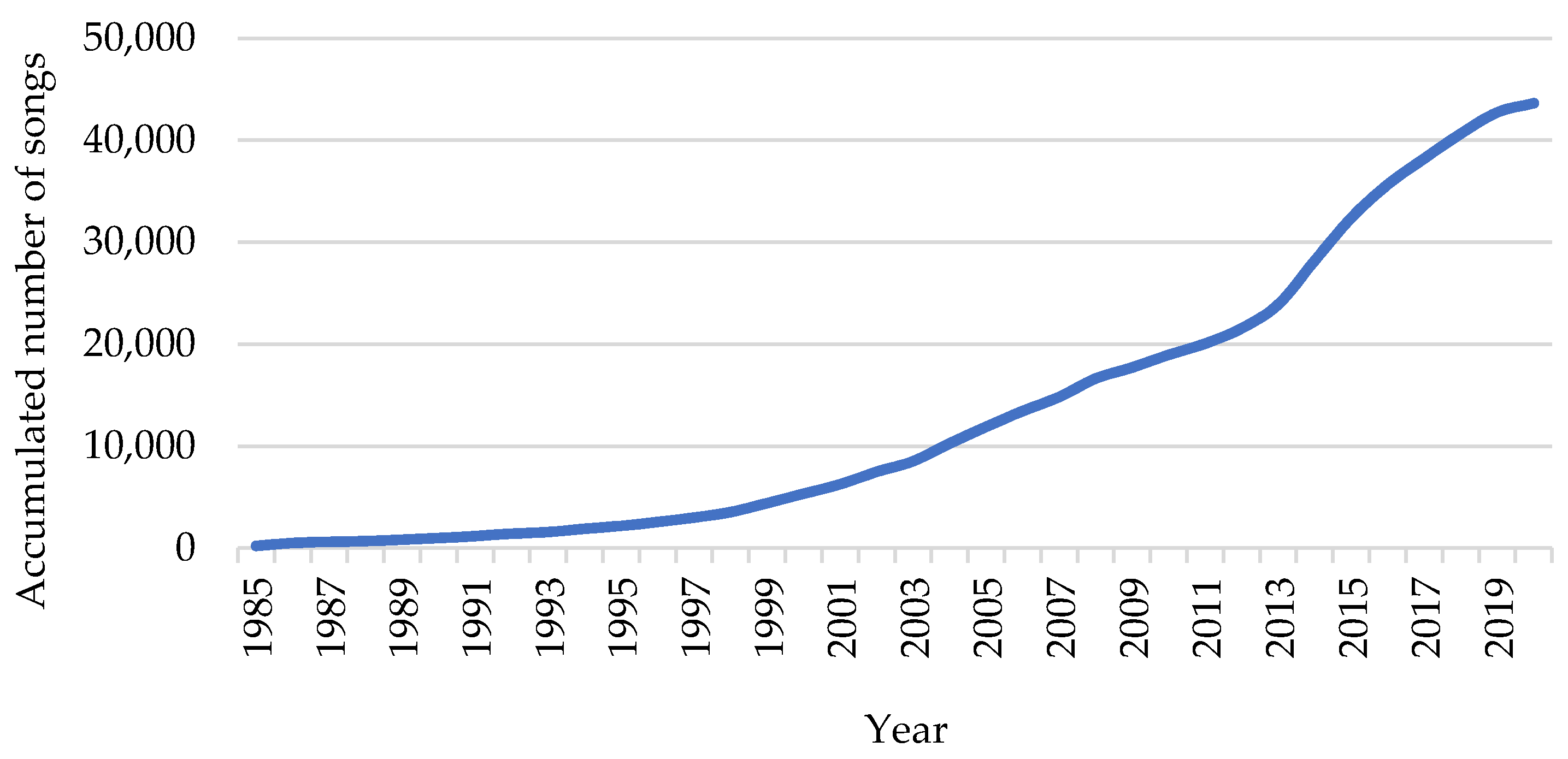
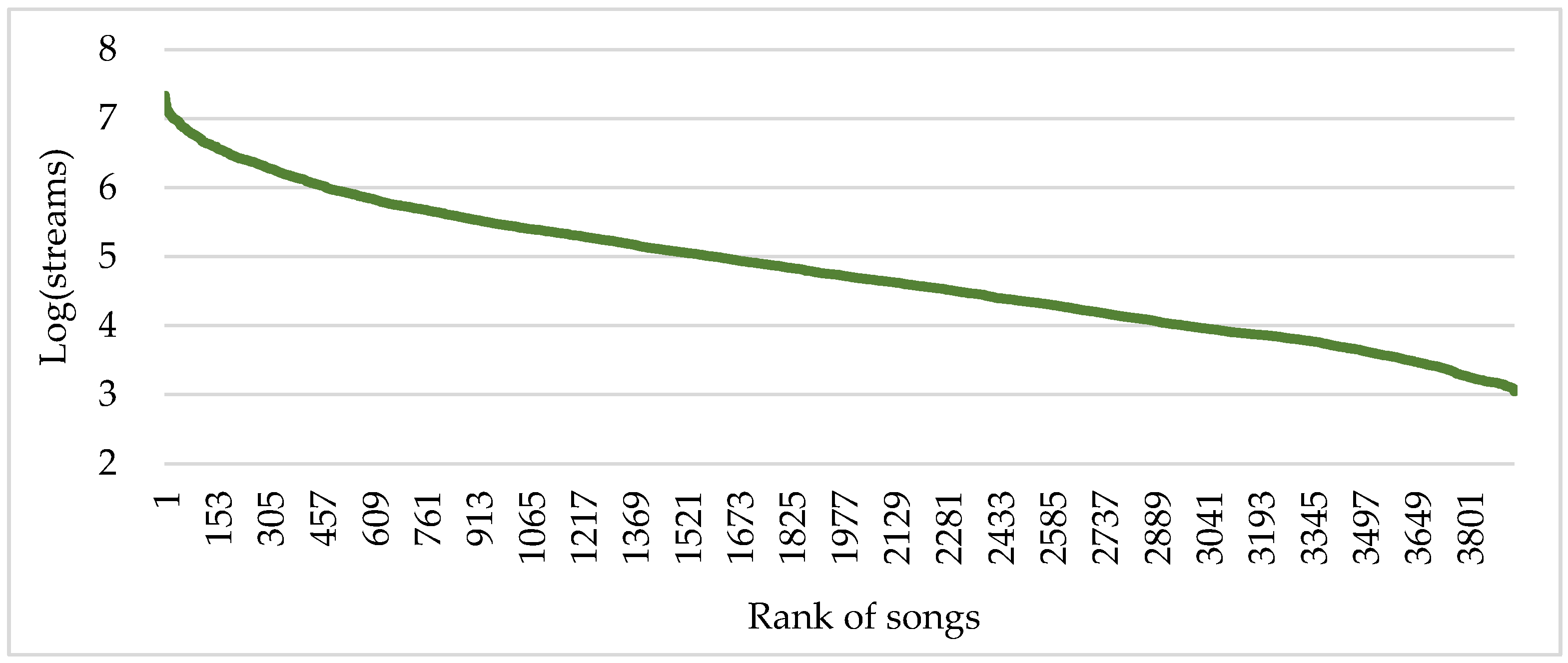


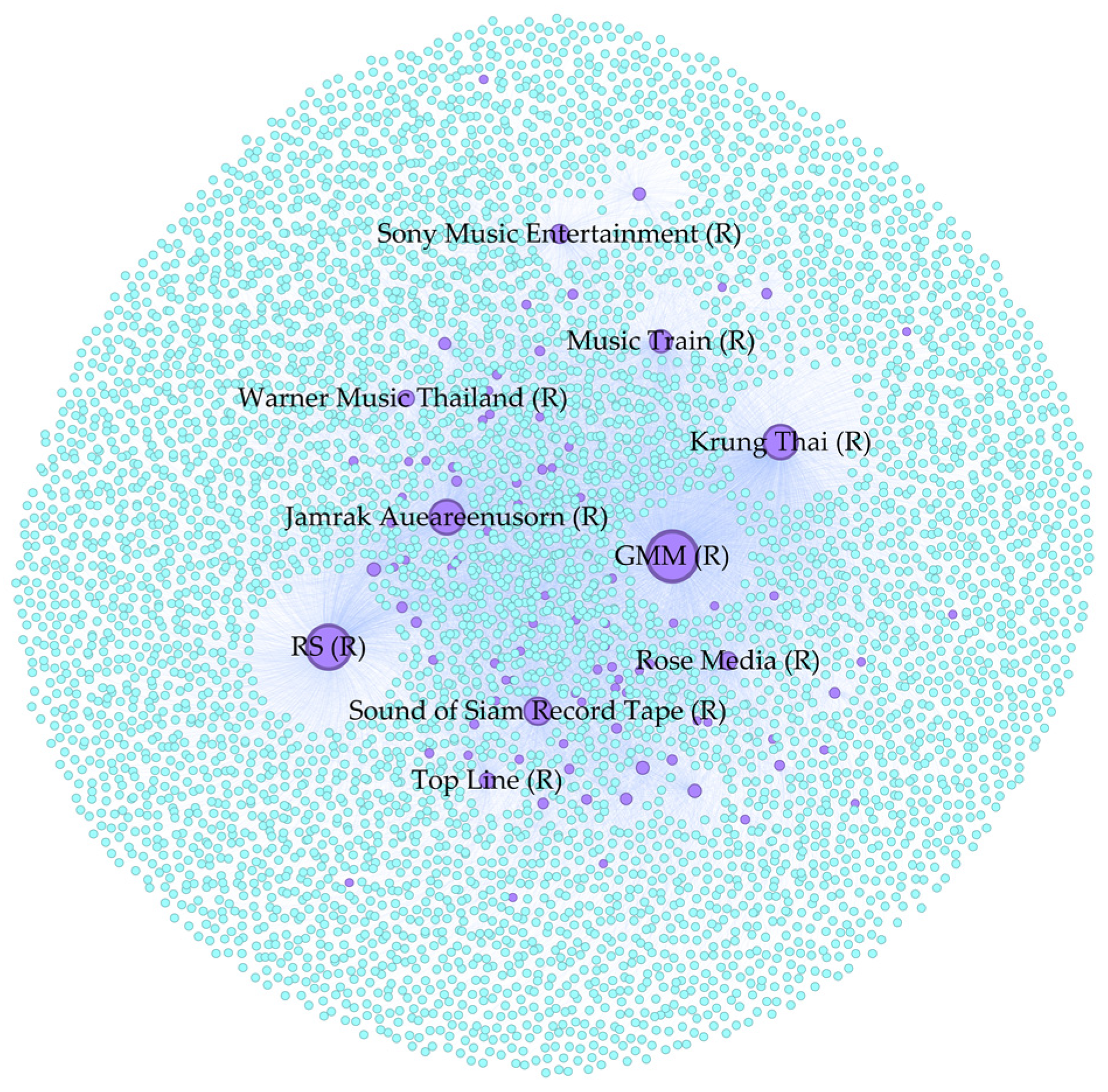
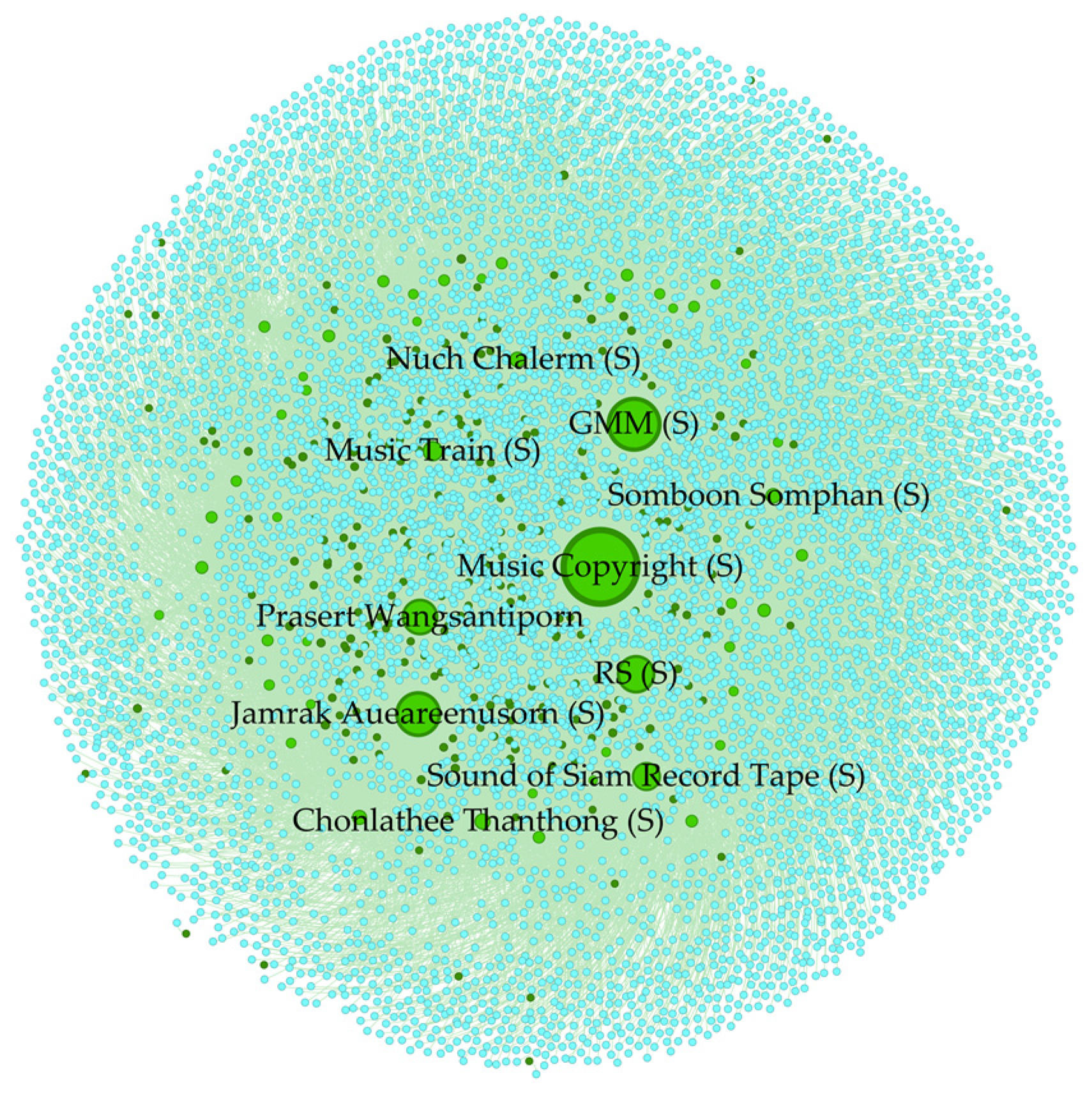
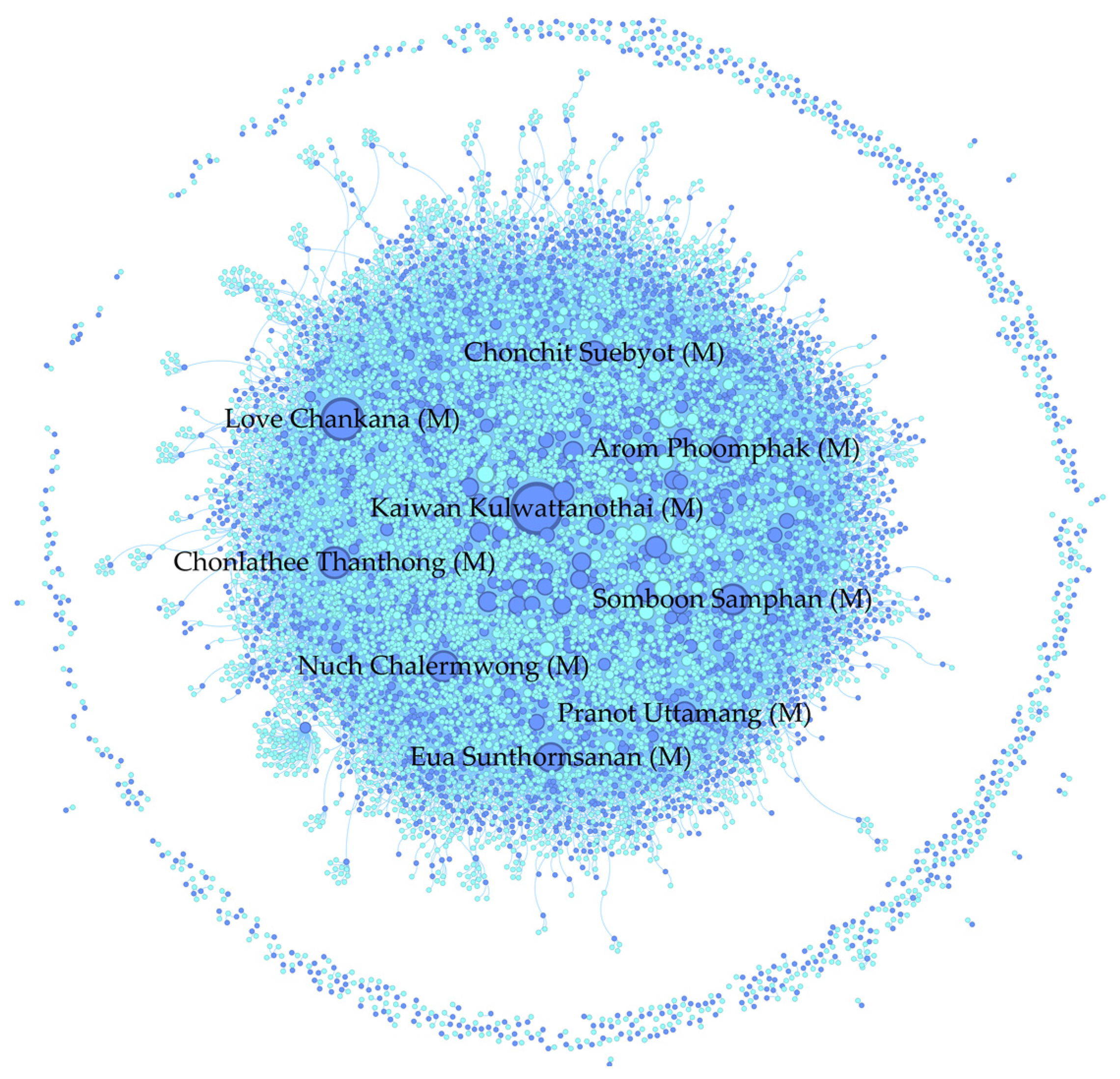


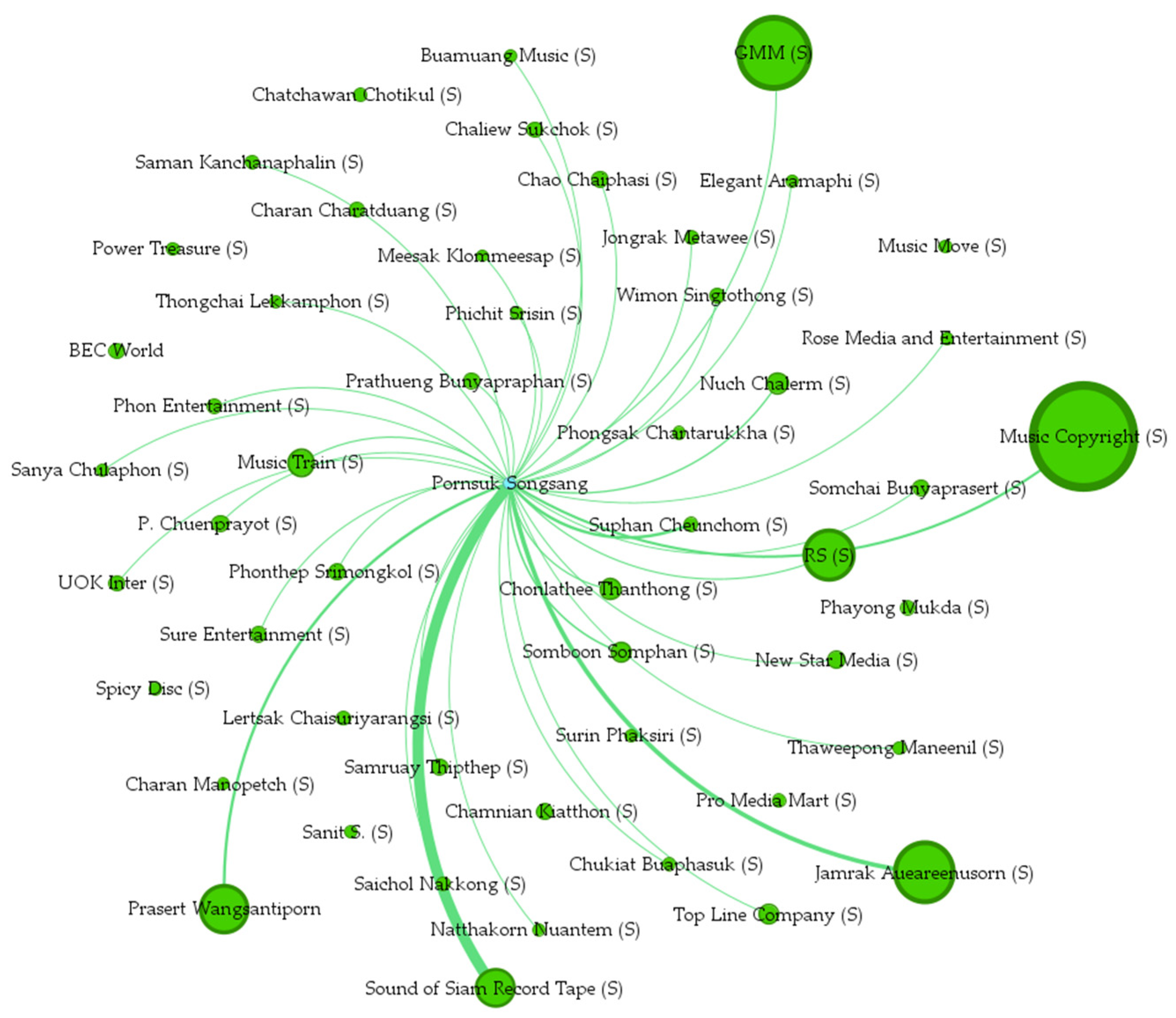
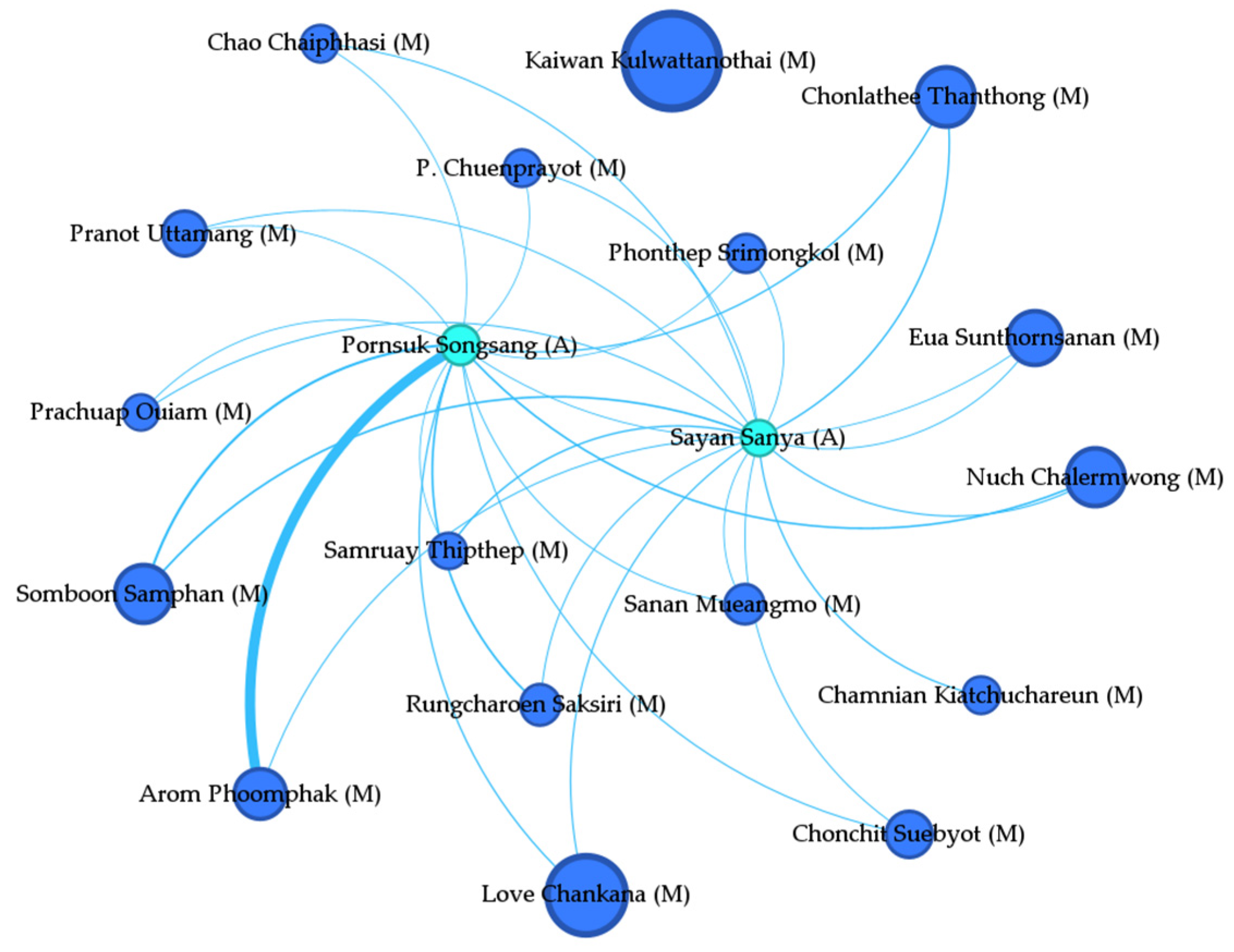
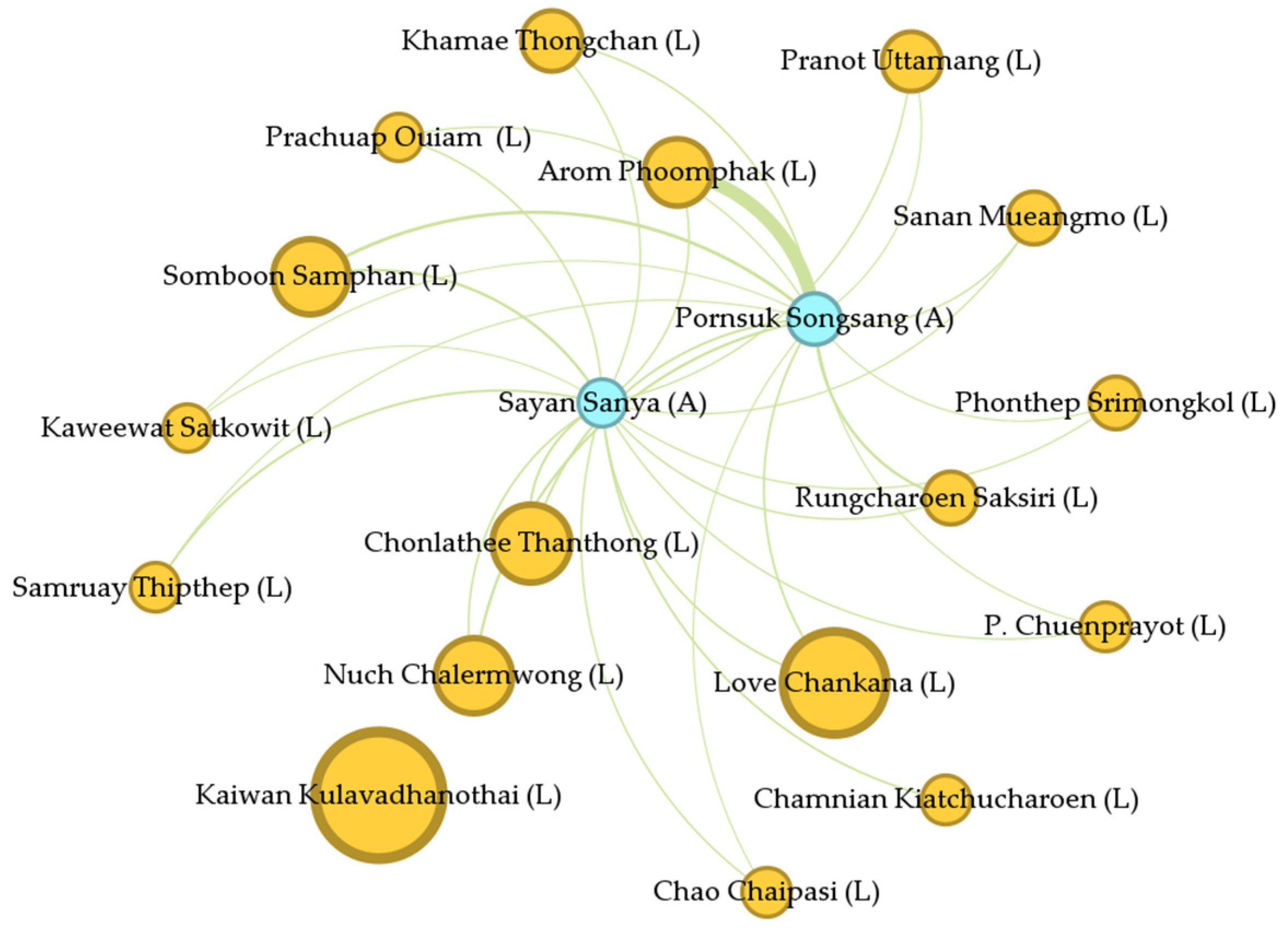
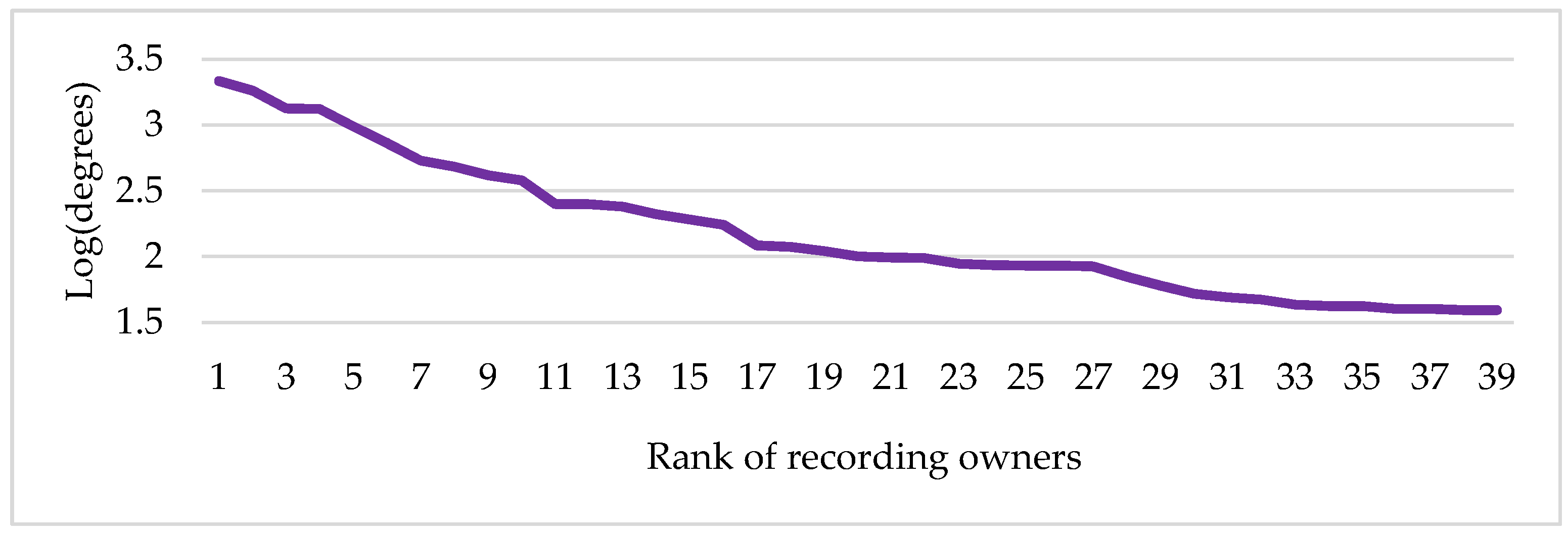
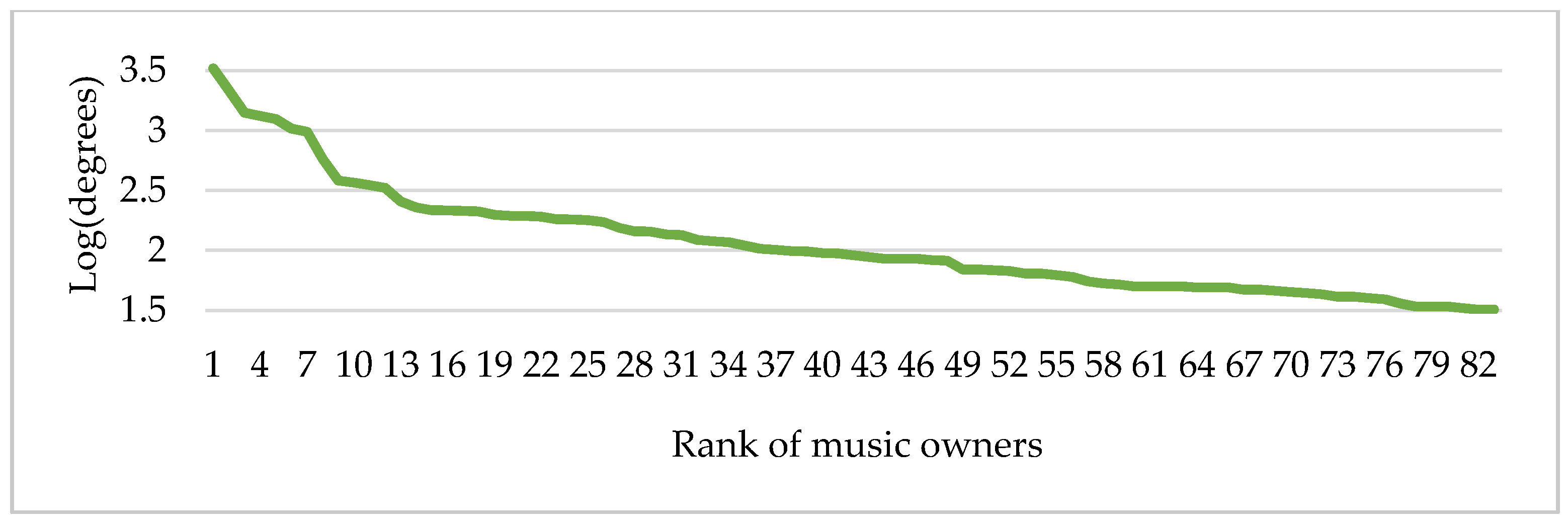


| Creator Category | Number |
|---|---|
| Recording owner | 101 |
| Music owner | 364 |
| Melody owner | 7584 |
| Lyric owner | 7969 |
| Artist | 8078 |
| Recording Owner–Artist | Music Owner–Artist | Melody Owner–Artist | Lyric Owner–Artist | |
|---|---|---|---|---|
| Constant | 4.3616 *** (0.0107) | 4.6112 *** (0.0101) | 4.7365 *** (0.0084) | 4.7087 *** (0.0082) |
| 1.1903 *** (0.0032) | 1.2266 *** (0.0029) | 1.18 *** (0.0023) | 1.1748 *** (0.0022) | |
| R-Squared | 0.9595 | 0.9597 | 0.9543 | 0.9554 |
| N | 5883 | 7445 | 13,146 | 13,238 |
| Recording Owner–Artist | Music Owner–Artist | Melody Owner–Artist | Lyric Owner–Artist | |
|---|---|---|---|---|
| Nodes | 5883 | 7444 | 13,146 | 13,238 |
| Edges | 13,659 | 21,391 | 39,533 | 39,607 |
| Average Degree | 4.644 | 5.747 | 6.014 | 5.984 |
| Average Weighted Degree | 12.119 | 12.625 | 7.824 | 7.771 |
| Network Diameter | 7 | 8 | 13 | 12 |
| Connected Components | 1 | 6 | 457 | 508 |
| Modularity | 0.477 | 0.395 | 0.452 | 0.454 |
| Average Path Length | 3.344 | 3.251 | 4.593 | 4.573 |
| Degree | Betweenness | PageRank | Eigencentrality | ||||||||
|---|---|---|---|---|---|---|---|---|---|---|---|
| Name | Creator Category | Degree | Name | Creator Category | Betweenness | Name | Creator Category | PageRank | Name | Creator Category | Eigencentrality |
| GMM | Recording owner | 2161 | GMM | Recording owner | 6,930,064 | GMM | Recording owner | 0.0861 | GMM | Recording owner | 1.0000 |
| RS | Recording owner | 1829 | RS | Recording owner | 5,153,199 | RS | Recording owner | 0.0658 | RS | Recording owner | 0.9011 |
| Jamrak Aueareenusorn | Recording owner | 1332 | Jamrak Aueareenusorn | Recording owner | 2,740,970 | Jamrak Aueareenusorn | Recording owner | 0.0416 | Krung Thai | Recording owner | 0.7268 |
| Krung Thai | Recording owner | 1325 | Krung Thai | Recording owner | 2,627,892 | Krung Thai | Recording owner | 0.0410 | Jamrak Aueareenusorn | Recording owner | 0.7225 |
| Sound of Siam Record Tape | Recording owner | 975 | Sound of Siam Record Tape | Recording owner | 1,639,873 | Sound of Siam Record Tape | Recording owner | 0.0293 | Sound of Siam Record Tape | Recording owner | 0.5476 |
| Music Train | Recording owner | 727 | Sony Music Entertainment | Recording owner | 1,510,457 | Music Train | Recording owner | 0.0226 | Music Train | Recording owner | 0.4027 |
| Sony Music Entertainment | Recording owner | 537 | Music Train | Recording owner | 1,262,719 | Sony Music Entertainment | Recording owner | 0.0207 | Rose Media | Recording owner | 0.2952 |
| Rose Media | Recording owner | 482 | Warner Music Thailand | Recording owner | 1,223,269 | Warner Music Thailand | Recording owner | 0.0167 | Sony Music Entertainment | Recording owner | 0.2262 |
| Warner Music Thailand | Recording owner | 415 | Spicy Disk | Recording owner | 706,442 | Rose Media | Recording owner | 0.0138 | Top Line | Recording owner | 0.2254 |
| Top Line | Recording owner | 380 | Rose Media | Recording owner | 564,638 | Top Line | Recording owner | 0.0110 | Chaiwut Truktrong | Recording owner | 0.1635 |
| Degree | Betweenness | PageRank | Eigencentrality | ||||||||
|---|---|---|---|---|---|---|---|---|---|---|---|
| Name | Creator Category | Degree | Name | Creator Category | Betweenness | Name | Creator Category | PageRank | Name | Creator Category | Eigencentrality |
| Music Copyright (Thailand) | Music owner | 3295 | Music Copyright (Thailand) | Music owner | 13,342,482 | Music Copyright (Thailand) | Music owner | 0.0911 | Music Copyright (Thailand) | Music owner | 1.0000 |
| GMM | Music owner | 2161 | GMM | Music owner | 8,061,172 | GMM | Music owner | 0.0565 | GMM | Music owner | 0.6412 |
| RS | Music owner | 1408 | RS | Music owner | 4,047,106 | RS | Music owner | 0.0318 | Prasert Wangsantiporn | Music owner | 0.4865 |
| Prasert Wangsantiporn | Music owner | 1322 | Prasert Wangsantiporn | Music owner | 2,632,669 | Prasert Wangsantiporn | Music owner | 0.0254 | Jamrak Aueareenusorn | Music owner | 0.4595 |
| Jamrak Aueareenusorn | Music owner | 1250 | Jamrak Aueareenusorn | Music owner | 2,430,279 | Jamrak Aueareenusorn | Music owner | 0.0237 | RS | Music owner | 0.4586 |
| Sound of Siam Record Tape | Music owner | 975 | Sound of Siam Record Tape | Music owner | 1,638,525 | Sound of Siam Record Tape | Music owner | 0.0181 | Sound of Siam Record Tape | Music owner | 0.3691 |
| Music Train | Music owner | 578 | Music Train | Music owner | 975,408 | Music Train | Music owner | 0.0110 | Music Train | Music owner | 0.2189 |
| Chonlathee Thanthong | Music owner | 382 | BEC World | Music owner | 505,057 | Chonlathee Thanthong | Music owner | 0.0064 | Chonlathee Thanthong | Music owner | 0.1683 |
| Nuch Chalermchai | Music owner | 368 | Top Line | Music owner | 400,338 | Nuch Chalermchai | Music owner | 0.0062 | Nuch Chalermchai | Music owner | 0.1619 |
| Somboon Samphan | Music owner | 350 | Spicy Disk | Music owner | 382,038 | Top Line | Music owner | 0.0060 | Somboon Samphan | Music owner | 0.1557 |
| Degree | Betweenness | PageRank | Eigencentrality | ||||||||
|---|---|---|---|---|---|---|---|---|---|---|---|
| Name | Creator Category | Degree | Name | Creator Category | Betweenness | Name | Creator Category | PageRank | Name | Creator Category | Eigencentrality |
| Kaiwan Kulwattanothai | Melody owner | 660 | Kaiwan Kulwattanothai | Melody owner | 8,084,163 | Kaiwan Kulwattanothai | Melody owner | 0.0215 | Chongrak Chankana | Melody owner | 1.0000 |
| Chongrak Chankana | Melody owner | 531 | Chongrak Chankana | Melody owner | 5,935,932 | Chongrak Chankana | Melody owner | 0.0051 | Chonlathee Thanthong | Melody owner | 0.8683 |
| Chonlathee Thanthong | Melody owner | 382 | Various Artists | Artist | 5,323,015 | Chonlathee Thanthong | Melody owner | 0.0033 | Somboon Samphan | Melody owner | 0.8408 |
| Nuch Chalermwong | Melody owner | 370 | Chonlathee Thanthong | Melody owner | 3,027,078 | Nuch Chalermwong | Melody owner | 0.0032 | Nuch Chalermwong | Melody owner | 0.8254 |
| Somboon Samphan | Melody owner | 367 | Nuch Chalermwong | Melody owner | 2,931,463 | Somboon Samphan | Melody owner | 0.0032 | Eua Sunthornsanan | Melody owner | 0.7325 |
| Eua Sunthornsanan | Melody owner | 345 | Somboon Samphan | Melody owner | 2,787,324 | Eua Sunthornsanan | Melody owner | 0.0031 | Arom Phoomphak | Melody owner | 0.6927 |
| Arom Phoomphak | Melody owner | 318 | Eua Sunthornsanan | Melody owner | 2,447,194 | PIERANTON | Melody owner | 0.0029 | Khamae Thongchan | Melody owner | 0.6646 |
| Khamae Thongchan | Melody owner | 279 | Bird Thongchai | Artist | 2,322,493 | Arom Phoomphak | Melody owner | 0.0028 | Pornsuk Songsang | Artist | 0.6645 |
| Pranot Uttamang | Melody owner | 272 | Arom Phoomphak | Melody owner | 2,154,826 | Khamae Thongchan | Melody owner | 0.0024 | Sayan Sanya | Artist | 0.6535 |
| Rungcharoen Serek | Melody owner | 236 | Pranot Uttamang | Melody owner | 2,020,457 | Pranot Uttamang | Melody owner | 0.0024 | Pranot Uttamang | Melody owner | 0.6279 |
| Degree | Betweenness | PageRank | Eigencentrality | ||||||||
|---|---|---|---|---|---|---|---|---|---|---|---|
| Name | Creator Category | Degree | Name | Creator Category | Betweenness | Name | Creator Category | PageRank | Name | Creator Category | Eigencentrality |
| Kaiwan Kulavadhanothai | Lyric owner | 659 | Kaiwan Kulavadhanothai | Lyric owner | 7,716,845 | Kaiwan Kulavadhanothai | Lyric owner | 0.0215 | Chongrak Chankana | Lyric owner | 1.0000 |
| Chongrak Chankana | Lyric owner | 531 | Chongrak Chankana | Lyric owner | 5,676,886 | Chongrak Chankana | Lyric owner | 0.0050 | Chonlathee Thanthong | Lyric owner | 0.8645 |
| Chonlathee Thanthong | Lyric owner | 382 | Various Artists | Artist | 5,117,055 | Chonlathee Thanthong | Lyric owner | 0.0033 | Somboon Samphan | Lyric owner | 0.8372 |
| Nuch Chalermwong | Lyric owner | 370 | Chonlathee Thanthong | Lyric owner | 3,053,777 | Nuch Chalermwong | Lyric owner | 0.0032 | Nuch Chalermwong | Lyric owner | 0.8231 |
| Somboon Samphan | Lyric owner | 366 | Nuch Chalermwong | Lyric owner | 2,953,369 | Somboon Samphan | Lyric owner | 0.0032 | Arom Phoomphak | Lyric owner | 0.6895 |
| Arom Phoomphak | Lyric owner | 318 | Somboon Samphan | Lyric owner | 2,812,346 | Arom Phoomphak | Lyric owner | 0.0028 | Khamae Thongchan | Lyric owner | 0.6649 |
| Khamae Thongchan | Lyric owner | 279 | Arom Phoomphak | Lyric owner | 2,088,924 | PIERANTON | Lyric owner | 0.0027 | Pornsuk Songsang | Artist | 0.6613 |
| Pranot Uttamang | Lyric owner | 272 | Bird Thongchai | Artist | 2,078,997 | Khamae Thongchan | Lyric owner | 0.0024 | Sayan Sanya | Artist | 0.6500 |
| Rungcharoen Serksiri | Lyric owner | 236 | Pranot Uttamang | Lyric owner | 1,965,217 | Pranot Uttamang | Lyric owner | 0.0024 | Pranot Uttamang | Lyric owner | 0.6271 |
| Sanan Muengmo | Lyric owner | 235 | Khamae Thongchan | Lyric owner | 1,933,807 | Pornthep Srimongkon | Lyric owner | 0.0021 | Mike Phiromphon | Artist | 0.6250 |
| Recording owner | 2.6722 | 1.0383 | 2.5737 |
| Music owner | 3.0091 | 1.0339 | 2.9106 |
| Melody owner | 17.5455 | 1.2254 | 14.3177 |
| Lyric owner | 19.8289 | 1.1875 | 16.6987 |
| Test | Result |
|---|---|
| The power law distribution (Easley–Kleinberg model) | Statistically confirmed |
| Social network analysis: Centrality indices | Networks were dominated by a small group of entities |
| Social network analysis: The small-world pattern (Watts–Strogatz model) | Statistically confirmed |
Disclaimer/Publisher’s Note: The statements, opinions and data contained in all publications are solely those of the individual author(s) and contributor(s) and not of MDPI and/or the editor(s). MDPI and/or the editor(s) disclaim responsibility for any injury to people or property resulting from any ideas, methods, instructions or products referred to in the content. |
© 2024 by the authors. Licensee MDPI, Basel, Switzerland. This article is an open access article distributed under the terms and conditions of the Creative Commons Attribution (CC BY) license (https://creativecommons.org/licenses/by/4.0/).
Share and Cite
Peechapat, W.; Puttanapong, N. Collaboration and Competition: A Social Network Analysis of Thailand’s Music Industry. Economies 2024, 12, 45. https://doi.org/10.3390/economies12020045
Peechapat W, Puttanapong N. Collaboration and Competition: A Social Network Analysis of Thailand’s Music Industry. Economies. 2024; 12(2):45. https://doi.org/10.3390/economies12020045
Chicago/Turabian StylePeechapat, Wichaya, and Nattapong Puttanapong. 2024. "Collaboration and Competition: A Social Network Analysis of Thailand’s Music Industry" Economies 12, no. 2: 45. https://doi.org/10.3390/economies12020045







